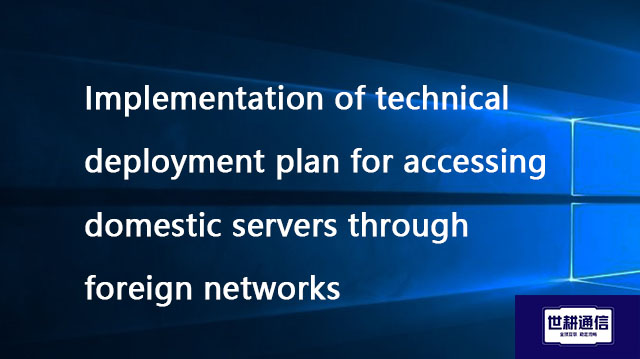Implementation of technical deployment plan for accessing domestic servers through foreign networks//Global IPLC service provider of Shigeng Communication
一、In the context of globalization, multinational corporations need to frequently exchange data between different countries. However, due to factors such as geographical distance, network environment differences, and policy restrictions, foreign users may encounter high latency, unstable connections, or even inability to access domestic servers. To address these issues, this article will explore in detail how to achieve efficient access from foreign networks to domestic servers through technological means, and propose specific deployment plans.
1. Problem analysis: The main challenges of accessing domestic servers from abroad
High latency caused by geographical distance
The physical distance between domestic servers and foreign users is relatively long, which increases signal transmission time and leads to increased network latency.
International bandwidth restrictions
International export bandwidth resources are limited, and peak periods may face congestion, affecting access speed and stability.
Policy and compliance requirements
Different countries have different legal and regulatory requirements for cross-border data transmission, such as China's Cybersecurity Law and GDPR (General Data Protection Regulation), which require ensuring that access complies with relevant regulations.
Firewall and Security Policy
Domestic servers may be protected by firewalls, which restrict access to certain IP addresses or ports, further increasing the difficulty of access.
Network path complexity
Data from abroad to China usually needs to go through multiple ISP nodes, and any problems in any link can affect overall performance.
2. Technical deployment plan
In order to achieve efficient access from foreign networks to domestic servers, the following aspects can be taken into account:
1. Build a dedicated network channel
SD-WAN: Through SD-WAN technology, a virtual private network can be built globally, optimizing traffic paths, reducing latency, and improving stability.
International dedicated line: Apply for a dedicated network line (such as MPLS dedicated line) from abroad to China, providing low latency and high stability connection services.
Virtual Private Network: For small and medium-sized enterprises as well as individual users, encrypted virtual private network channels can be used to ensure the security and privacy of data transmission.
2. Utilize CDN acceleration
Deploy a Content Delivery Network (CDN) to cache static resources (such as images, videos, files, etc.) to edge nodes near users, reducing data round-trip time.
Choose CDN services that support global coverage and optimize the transmission path of dynamic content.
3. Optimize DNS resolution
Using intelligent DNS resolution services to return the nearest server IP address based on the user's geographic location, thereby shortening the access path.
Ensure fast and stable DNS resolution process to avoid overall access speed degradation caused by DNS latency.
4. Load balancing and distributed architecture
Deploy a load balancer in front of domestic servers to distribute access requests from overseas and avoid overloading a single server.
Consider deploying mirror servers or cache nodes in overseas regions close to the target users to reduce direct access pressure on domestic main servers.
5. Optimize network protocols
Replace traditional HTTP/1.1 or HTTP/2 with HTTP/3 protocol to reduce the latency caused by TCP handshake and congestion control.
Enable QUIC protocol to improve transmission efficiency in unstable network environments.
6. Strengthen security
Configure firewall rules to only allow specific IP addresses or regions to access the server, preventing malicious attacks.
Use SSL/TLS encryption for communication to ensure that data is not stolen or tampered with during transmission.
Regularly update server security patches to prevent potential vulnerabilities.
7. Monitoring and optimization
Deploy real-time monitoring tools to track network performance metrics such as latency, packet loss rate, throughput, etc.
Adjust network configuration based on monitoring data and continuously optimize access experience.
conclusion
Realizing efficient access from foreign networks to domestic servers is a complex project that requires comprehensive consideration of various factors such as technology, cost, and compliance. By building a dedicated network, using CDN acceleration, optimizing DNS resolution, and other means, problems such as high latency and unstable connections can be effectively solved. Meanwhile, with the continuous development of technology, there will be more innovative solutions emerging in the future to help enterprises better cope with the network challenges brought by globalization.

二、Shigeng Communication Global Office Network Products:
The global office network product of Shigeng Communication is a high-quality product developed by the company for Chinese and foreign enterprise customers to access the application data transmission internet of overseas enterprises by making full use of its own network coverage and network management advantages.
Features of Global Application Network Products for Multinational Enterprises:
1. Quickly access global Internet cloud platform resources
2. Stable and low latency global cloud based video conferencing
3. Convenient and fast use of Internet resource sharing cloud platform (OA/ERP/cloud storage and other applications
Product tariff:
Global office network expenses | Monthly rent payment/yuan | Annual payment/yuan | Remarks |
Quality Package 1 | 1000 | 10800 | Free testing experience for 7 days |
Quality Package 2 | 1500 | 14400 | Free testing experience for 7 days |
Dedicated line package | 2400 | 19200 | Free testing experience for 7 days |







